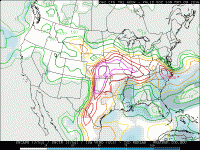Paul Knightley
EF5
An amplified flow regime around the NH seems to be progged for at least the next 10 days - e.g. over here in Europe we're looking at major upper troughing later next week downstream from a large mid-Atlantic upper ridge, itself downstream from a major eastern US upper trough. I would expect several bouts of cP air to move into the Gulf through next weekend, with (e.g. ECMWF ensembles) still showing an eastern trough into the start of the next week. However, amplified wave patterns break sooner or later and I suspect that a more low amplitude pattern should emerge from around April 13/14th onwards. EC ensembles hint at this fact although one has to be careful as they typically will show a more climatological look late in the run. One not-so-favourable feature is the persistence throughout the run of a trough close to Hudson Bay.

